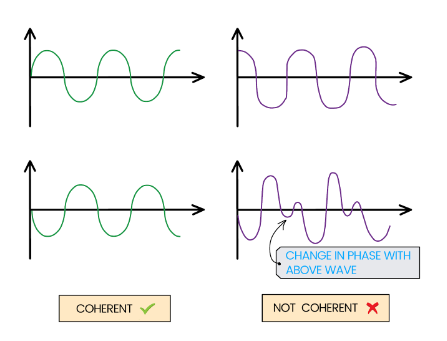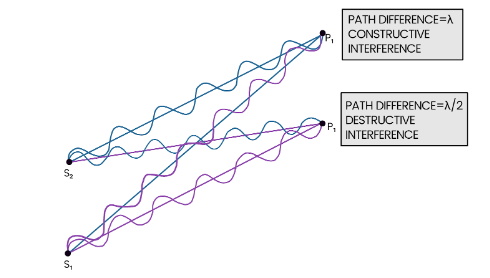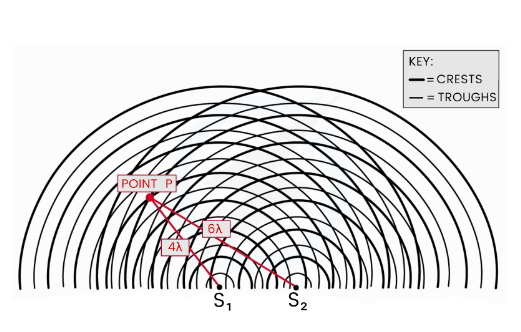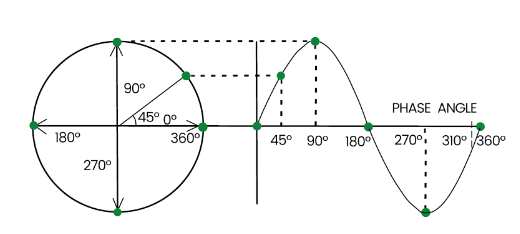Path Difference
Coherence & Path Difference
- The phenomenon of interference happens when waves converge and their combined displacement is the sum of the displacement of each wave
- This outcome is derived from the principle of superposition, and the resultant wave can be either smaller or larger than the individual waves
Coherence
- locations where the two waves are not perfectly in phase or out of phase, the resultant amplitude lies somewhere between the two extremes
- Waves exhibit coherence if they share:
- Identical frequency
- A consistent phase offset

- The presence of coherence is essential to generate a visible or audible interference pattern
- Laser light serves as an illustration of a coherent source of light, whereas incandescent bulbs emit incoherent light waves
- Constructive interference amplifies the sound level when coherent sound waves are in phase
Path Difference
- Path difference can be defined as:
The variation in the distance that two waves travel from their respective sources to the point of their intersection
- Typically, path difference is measured in terms of multiples of the wavelength

- The above diagram indicates the number of wavelengths between:
- S1 ➜ P1 = 6λ
- S2 ➜ P1 = 6.5λ
- S1 ➜ P2 = 7λ
- S2 ➜ P2 = 6λ
- At point P1, the path difference can be calculated as 6.5λ – 6λ, which simplifies to λ/2
- At point P2, the path difference is equivalent to 7λ – 6λ, which simplifies to λ
- Typically:
- Constructive interference is achieved when the path difference is equal to nλ
- Destructive interference is observed when the path difference equals (n + ½)λ
- In this instance, the variable n represents an integer value, such as 0, 1, 2, 3…

- An alternative representation of waves propagating from two sources is depicted in the diagram above
- At point P, the count of wave crests originating from:
- Source S1 is 4λ
- Source S2 is 6λ
- The path difference at P can be calculated as 6λ – 4λ, resulting in 2λ
- As this value corresponds to a complete number of wavelengths, constructive interference is observed at point P
Path Difference & Phase
- Coherence is a property of waves that exists when they possess:
- Identical frequency
- A consistent phase difference
Phase Difference
- When two points lie at the same position in their respective wave cycles, whether on the same or different waves, they are considered to be in phase
- The phase difference between them is determined by the angle between their wave cycles

Path difference is the difference in distance that two waves must travel from their sources to a given point. It plays a crucial role in wave interference, where waves can either reinforce or cancel each other out depending on their path difference.
Path difference is calculated by finding the difference in distance that two waves have traveled to a given point. This can be done using the formula: path difference = (distance traveled by wave 2) – (distance traveled by wave 1)
Path difference determines whether waves interfere constructively or destructively. When the path difference is a multiple of the wavelength of the waves, they interfere constructively and create a larger amplitude. When the path difference is an odd multiple of half the wavelength, they interfere destructively and cancel each other out.
Path difference is observed in many natural phenomena, such as the colors seen in thin-film interference on soap bubbles, the patterns observed in diffraction grating experiments, and the interference patterns created by radio waves from multiple sources.
Path difference is directly related to wavelength, as waves with longer wavelengths will require a greater path difference to interfere constructively. Frequency does not directly affect path difference, but it does determine the wavelength of a wave.
Path difference is a fundamental concept in wave physics that underpins many real-world phenomena. It is crucial for understanding wave interference and can be applied to a wide range of fields, including optics, acoustics, and telecommunications.
To solve problems involving path difference, it is important to understand the fundamental concepts behind wave interference and to apply the relevant formulas and calculations. Practice problems and past exam questions can help you build your problem-solving skills and prepare for exams.






Still got a question? Leave a comment
Leave a comment